To create emotional narratives in mobile photography, start by capturing authentic moments with genuine expressions. Use lighting strategically to set the mood, whether it's soft and dreamy or dramatic and intense. Frame your shots with intention, applying composition techniques like the rule of thirds and leading lines. Play with perspective to add depth and intrigue to your images. Don't shy away from imperfections; they can add charm and authenticity to your photos. Create a cohesive color palette to enhance the mood and narrative. Finally, sequence your images thoughtfully for maximum impact. These tips will help you unveil the power of visual storytelling right from your smartphone.
Capture Authentic Moments

To kick off your journey in emotional mobile photography, focus on capturing authentic moments. Train your eye to spot genuine expressions, spontaneous interactions, and unscripted scenes in everyday life. Keep your phone readily accessible to seize fleeting opportunities. Look for raw emotions: joy, sadness, surprise, or contemplation.
Don't stage or force situations; instead, observe and anticipate. Be patient and wait for the right moment to unfold naturally. Pay attention to body language, facial expressions, and environmental context that contribute to the emotional narrative. Capture people in their element, whether it's a child's laughter at the park or a stranger's pensive gaze on a busy street.
Use your phone's burst mode or live photo features to capture a series of images, increasing your chances of catching the perfect emotional moment. Practice being discreet to avoid disrupting the scene. Experiment with different angles and compositions to emphasize the emotional impact.
Use Lighting for Mood
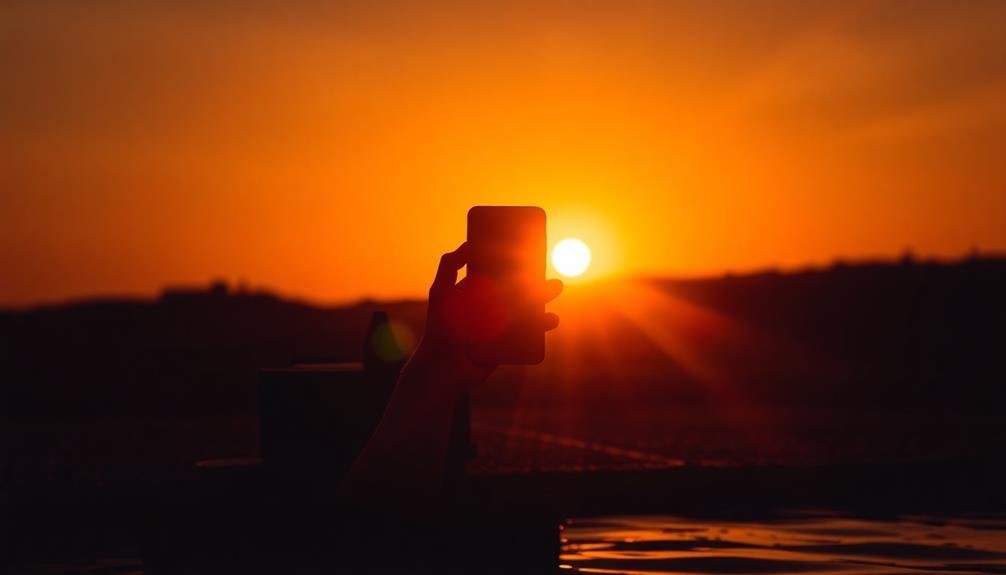
Lighting plays an essential role in setting the mood for emotional mobile photography. It can transform an ordinary scene into an enchanting narrative, evoking powerful feelings in your viewers.
To harness light effectively, pay attention to its quality, direction, and intensity. Soft, diffused light often creates a dreamy, introspective atmosphere, while harsh, direct light can convey drama or tension.
Experiment with different times of day to capture diverse moods. Golden hour, just after sunrise or before sunset, bathes subjects in warm, flattering light that's perfect for nostalgic or romantic shots.
Blue hour, during twilight, casts a cool, ethereal glow ideal for mysterious or melancholic scenes. Don't shy away from challenging lighting conditions; they can add depth to your storytelling.
Consider these techniques to enhance mood through lighting:
- Use shadows to create intrigue or emphasize emotions
- Incorporate silhouettes for dramatic effect
- Leverage backlighting to create a sense of hope or revelation
Frame With Intention
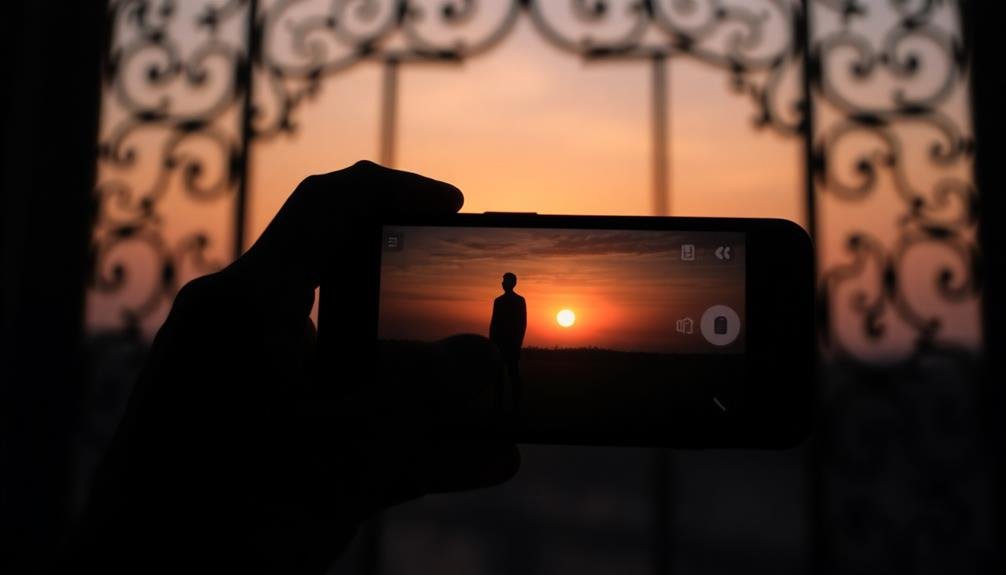
Frame your shots with purpose to enhance their emotional impact.
You'll create more compelling narratives by using leading lines to guide the viewer's eye and evoke feelings of movement or stillness.
Remember the rule of thirds to place key elements strategically, balancing your composition and drawing attention to the most emotionally resonant parts of your image.
Compose for Emotional Impact
When composing for emotional impact in mobile photography, thoughtful framing can make all the difference. Consider the story you want to tell and how your subject's placement within the frame can enhance that narrative.
Use the rule of thirds to create tension or harmony, depending on your intended emotional effect. Experiment with negative space to evoke feelings of isolation or freedom.
Pay attention to leading lines and how they guide the viewer's eye through the image. These can create a sense of movement or draw attention to key elements that convey emotion.
Don't forget about the power of perspective; shooting from a low angle can make your subject appear powerful, while a high angle might make them seem vulnerable.
To maximize emotional impact in your mobile photography:
- Focus on facial expressions and body language
- Use color psychology to set the mood
- Incorporate environmental elements that support the narrative
Use Leading Lines
Leading lines are powerful tools in your mobile photography arsenal, guiding your viewer's eye through the image and creating a sense of depth and movement.
To effectively use leading lines, start by identifying natural or man-made elements in your scene that form strong, directional lines. These could be roads, fences, buildings, or even natural features like rivers or tree branches.
Once you've identified potential leading lines, position your camera to emphasize these elements. Experiment with different angles and perspectives to find the most compelling composition.
Try aligning the lines with the corners or edges of your frame for added impact. Remember that leading lines don't always have to be straight; curved or winding lines can add a sense of flow and rhythm to your image.
Use leading lines to draw attention to your main subject or to create a journey through the frame. They can also be employed to convey emotions: upward lines might suggest hope or aspiration, while downward lines could imply sadness or defeat.
Rule of Thirds
The Rule of Thirds is a fundamental composition technique that can dramatically improve your mobile photography. It involves dividing your frame into a 3×3 grid and placing key elements along these lines or at their intersections.
This simple yet powerful approach creates balance and visual interest in your images, drawing the viewer's eye to the most important parts of your composition.
To effectively use the Rule of Thirds in your mobile photography:
- Enable the grid feature on your smartphone's camera app
- Position your main subject at one of the intersecting points
- Align horizons or other strong horizontal elements along the top or bottom horizontal line
Play With Perspective

To create emotionally compelling mobile photos, experiment with perspective.
Try shooting from low angles to make subjects appear larger-than-life, or use unusual framing techniques to challenge viewers' expectations.
Don't forget to explore reflections and distortions, which can add depth and intrigue to your images.
Low Angles, Big Impact
Smartphones, with their compact size and versatile cameras, offer a unique opportunity to explore low-angle photography. By positioning your device close to the ground, you'll capture scenes from a fresh perspective, adding drama and intrigue to your images.
This technique works particularly well for photographing pets, children, or architectural elements, as it emphasizes their size and presence in the frame.
To make the most of low-angle shots:
- Get down low: Crouch, kneel, or even lie on the ground to achieve the desired angle.
- Use the grid feature: Align your subject with the lower third of the frame for a more dynamic composition.
- Experiment with foreground elements: Include objects in the immediate foreground to create depth and lead the viewer's eye.
When shooting from low angles, be mindful of your surroundings and potential obstacles. You'll often need to adjust your position multiple times to find the perfect shot.
Don't be afraid to get creative with your angles – tilting your phone slightly can add an extra layer of interest to your images. Remember, low-angle photography isn't just about making subjects appear larger; it's about telling a story from a unique vantage point.
Unusual Framing Techniques
While low angles offer a unique perspective, mobile photographers can push their creativity even further by exploring unusual framing techniques.
You can create enchanting images by breaking traditional composition rules and embracing unconventional approaches.
Try framing your subject through natural elements like leaves, branches, or architectural features. This technique adds depth and intrigue to your shots.
Experiment with partial framing, where you deliberately cut off parts of your subject, leaving viewers to fill in the blanks with their imagination.
Don't shy away from tilted horizons or Dutch angles to convey a sense of unease or dynamic energy.
Use reflections in puddles, windows, or mirrors to create surreal, dream-like compositions.
Play with shadows and silhouettes to add mystery and drama to your photos.
Consider incorporating negative space to draw attention to your subject or evoke a feeling of isolation.
You can also try shooting through objects like fences or fabric to add texture and create a sense of voyeurism or intimacy.
Reflections and Distortions
Reflections and distortions offer mobile photographers a playground of creative possibilities to manipulate perspective and challenge viewers' perceptions. By capturing reflections in water, glass, or metallic surfaces, you can create dreamlike scenes that evoke emotion and intrigue.
Experiment with puddles after rain, mirrored buildings, or even car windows to add depth and layers to your compositions.
Distortions, whether natural or artificial, can intensify the emotional impact of your photos. Use curved surfaces, prisms, or specialized lenses to bend light and create surreal effects. These techniques can convey feelings of confusion, wonder, or disorientation, depending on your artistic intent.
To effectively use reflections and distortions in your mobile photography:
- Look for unconventional reflective surfaces in your environment.
- Experiment with different angles to find the most compelling composition.
- Consider combining reflections with other elements for added complexity.
Don't be afraid to push the boundaries of reality with these techniques. By manipulating perspective through reflections and distortions, you can create visually striking images that resonate emotionally with your audience and tell unique stories through your mobile lens.
Embrace Imperfections
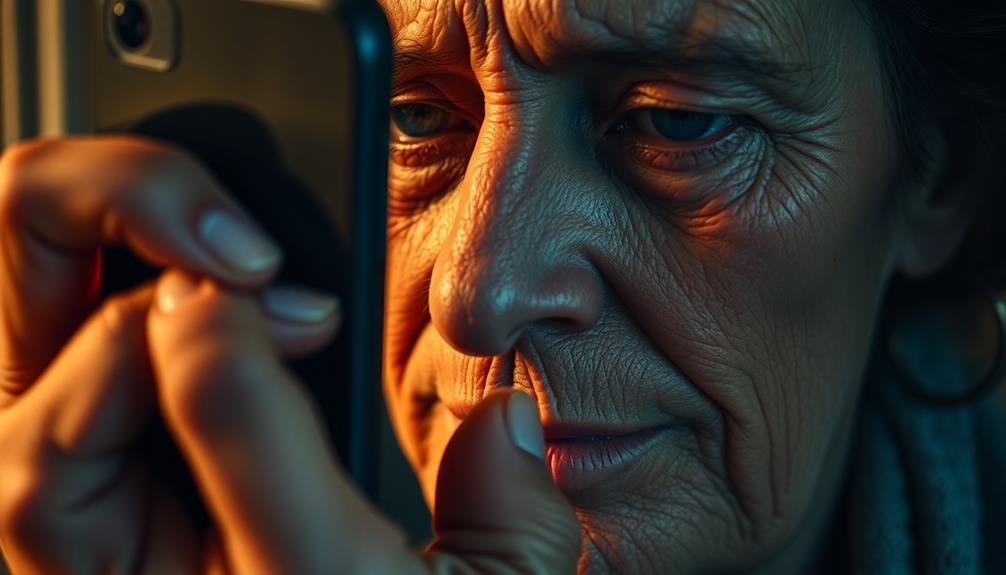
Imperfections are the secret ingredients that make your mobile photos truly enchanting. Embrace the flaws, quirks, and unexpected elements that arise during your mobile photography sessions. Instead of aiming for polished perfection, allow the rawness of real-life moments to shine through.
Don't shy away from motion blur, lens flares, or unusual framing. These imperfections can add depth and emotion to your images. Experiment with intentionally out-of-focus shots to create a dreamlike atmosphere. Capture candid moments with all their beautiful imperfections intact.
Use your phone's limitations to your advantage. The lower resolution or noise in low-light situations can lend a gritty, authentic feel to your photos. Embrace the unique characteristics of your device's camera, such as color shifts or digital artifacts.
When editing, resist the urge to over-polish. Leave in some grain, preserve shadows, and maintain the natural color palette. These imperfections tell a story and evoke emotions that pristine images often lack.
Create a Cohesive Color Palette
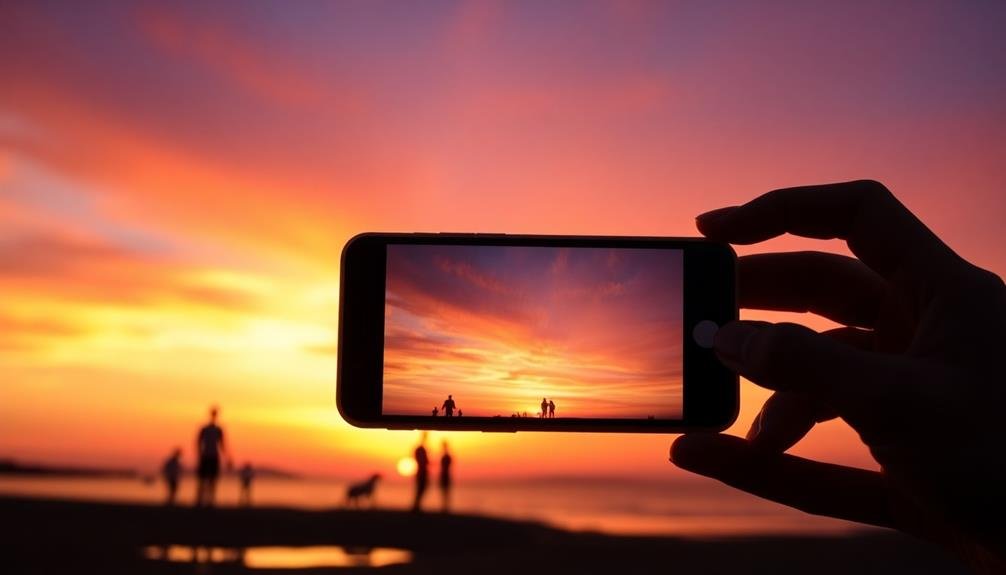
Color harmony is the key to creating visually striking and emotionally resonant mobile photographs. By curating a cohesive color palette, you'll enhance the mood and narrative of your images. Start by identifying the dominant colors in your scene and consider how they interact with each other.
Use your phone's editing tools to adjust hues, saturation, and temperature to achieve a harmonious balance.
To create a cohesive color palette:
- Choose a primary color that captures the essence of your story
- Select complementary or analogous colors to support the main hue
- Incorporate neutral tones to balance and ground your composition
Experiment with color grading techniques to evoke specific emotions. Warm tones like oranges and yellows can convey happiness and energy, while cool blues and greens might suggest calmness or melancholy.
Don't be afraid to push the boundaries of reality – sometimes an unexpected color treatment can make your image more impactful.
Remember that consistency is essential when developing your style. Try to maintain a similar color approach across a series of photos to create a cohesive narrative.
This will help viewers connect with your story on a deeper level and enhance the overall emotional impact of your mobile photography.
Sequence Images for Impact
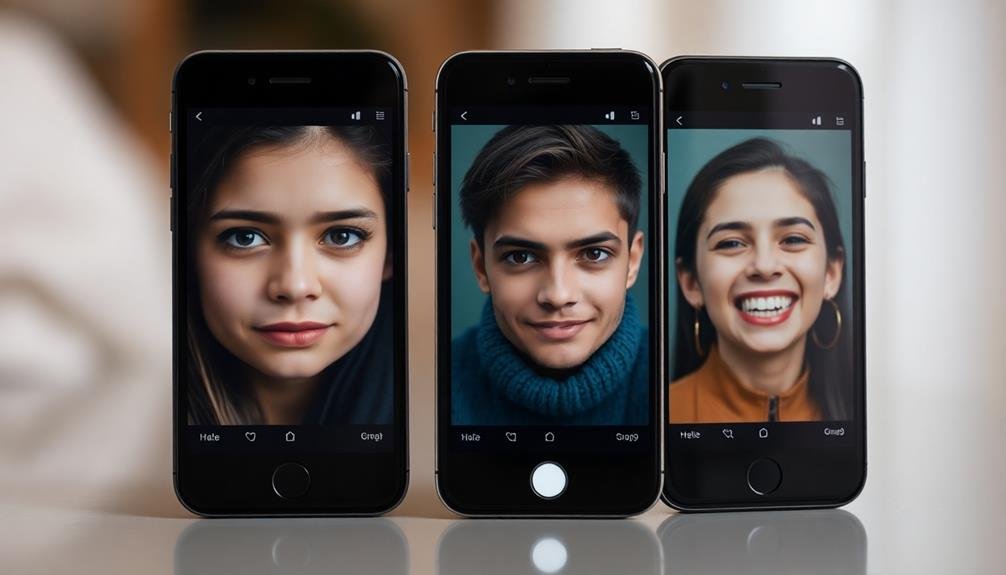
Sequencing your images can dramatically amplify the emotional impact of your mobile photography. When arranging your photos, consider the story you're trying to tell and how each image contributes to that narrative. Start with a strong opening shot that sets the tone and captures the viewer's attention.
Then, build tension and interest by carefully selecting the order of subsequent images. Use contrasting elements to create visual interest and emotional depth. For example, pair a wide landscape shot with a close-up detail to show scale and intimacy.
Experiment with different rhythms in your sequence, such as alternating between busy and calm scenes to create a sense of pacing. Consider the emotional journey you want your viewers to experience. You might choose to build towards a climax or create a circular narrative that ends where it began.
Pay attention to the visual flow between images, using similar colors, shapes, or themes to create a cohesive sequence. Don't be afraid to include unexpected elements that surprise and engage your audience, keeping them invested in your visual story.
Frequently Asked Questions
How Can I Handle Ethical Concerns When Photographing Emotional Moments?
When capturing emotional moments, you'll need to prioritize respect and consent. Ask for permission, be sensitive to people's privacy, and don't exploit vulnerable situations. Consider the impact of your images and always put ethics before your shot.
What Apps Are Best for Editing Emotional Mobile Photographs?
You'll find VSCO, Snapseed, and Lightroom Mobile excellent for editing emotional photos. They offer tools to enhance mood, adjust lighting, and add filters. Don't overdo it; subtle edits often work best to preserve authenticity in emotional shots.
How Do I Approach Strangers for Candid Emotional Shots?
When approaching strangers for candid emotional shots, you'll want to be respectful and discreet. Use a small camera, blend into the environment, and don't be intrusive. If caught, explain your intentions politely and offer to delete the photo.
Can I Use Filters While Maintaining Authenticity in Emotional Narratives?
You can use filters, but use them sparingly. They shouldn't overpower the raw emotion in your shots. Subtle enhancements can emphasize mood, but authenticity comes from the subject's genuine expressions and the moment's natural atmosphere.
How Often Should I Post Emotional Narrative Photo Series on Social Media?
You should post emotional narrative photo series based on your comfort level and audience engagement. Don't overwhelm your followers. Aim for quality over quantity. Try starting with a weekly or bi-weekly schedule, then adjust as needed.
In Summary
You've learned powerful techniques to infuse emotion into your mobile photography. Now it's time to put them into practice. Don't be afraid to experiment and push your creative boundaries. Remember, the most impactful images often come from unexpected moments. Trust your instincts, stay observant, and let your unique perspective shine through. With these tools at your disposal, you're ready to capture and share stories that resonate deeply with your audience. Go out and create!





Leave a Reply